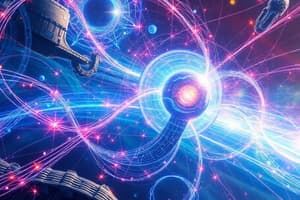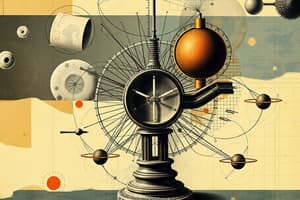Podcast
Questions and Answers
What is the formula for calculating kinetic energy?
What is the formula for calculating kinetic energy?
- KE = mgh
- KE = F/d
- KE = mv
- KE = 1/2 mv² (correct)
Which of Newton's Laws of Motion states that an object in motion stays in motion unless acted upon by a force?
Which of Newton's Laws of Motion states that an object in motion stays in motion unless acted upon by a force?
- Conservation of Momentum
- 1st Law (correct)
- 3rd Law
- 2nd Law
What is characterized by the oscillation being perpendicular to the direction of wave travel?
What is characterized by the oscillation being perpendicular to the direction of wave travel?
- Transverse wave (correct)
- Longitudinal wave
- Mechanical wave
- Electromagnetic wave
What principle states that energy cannot be created or destroyed, only transformed?
What principle states that energy cannot be created or destroyed, only transformed?
What law describes the forces between charged objects?
What law describes the forces between charged objects?
Flashcards are hidden until you start studying
Study Notes
Key Concepts in Physics
1. Mechanics
- Motion: Study of objects in motion; includes concepts of displacement, velocity, and acceleration.
- Forces: Interactions that cause changes in motion; includes gravitational, electromagnetic, and frictional forces.
- Newton's Laws of Motion:
- 1st Law: An object at rest stays at rest; an object in motion stays in motion unless acted upon by a force.
- 2nd Law: F = ma (Force equals mass times acceleration).
- 3rd Law: For every action, there is an equal and opposite reaction.
2. Energy
- Kinetic Energy (KE): Energy of motion; KE = 1/2 mv², where m is mass and v is velocity.
- Potential Energy (PE): Stored energy due to position; PE = mgh, where g is acceleration due to gravity and h is height.
- Conservation of Energy: Total energy in a closed system remains constant; energy can transform but not be created or destroyed.
3. Thermodynamics
- Laws of Thermodynamics:
- 1st Law: Energy cannot be created or destroyed, only transformed.
- 2nd Law: Entropy of an isolated system always increases; heat cannot spontaneously flow from cold to hot.
- Heat Transfer: Conduction (direct contact), convection (fluid movement), radiation (electromagnetic waves).
4. Waves and Oscillations
- Wave Properties: Wavelength, frequency, amplitude, speed.
- Types of Waves:
- Transverse: Oscillation perpendicular to the direction of wave travel (e.g., light waves).
- Longitudinal: Oscillation parallel to the direction of wave travel (e.g., sound waves).
- Sound: A longitudinal wave that travels through a medium; characterized by frequency (pitch) and amplitude (loudness).
5. Electromagnetism
- Electric Forces: Forces between charged objects; described by Coulomb's law.
- Magnetic Forces: Forces between magnets and moving charges; described by Lorentz force law.
- Maxwell's Equations: Set of four equations that describe how electric and magnetic fields interact.
6. Modern Physics
- Quantum Mechanics: Study of particles at the atomic and subatomic levels; includes principles of wave-particle duality and uncertainty.
- Relativity: Einstein's theories explaining gravity and the behavior of objects at high speeds:
- Special Relativity: Time and space are relative; E=mc² relates energy and mass.
- General Relativity: Gravity is the curvature of spacetime caused by mass.
7. Atomic and Nuclear Physics
- Atoms: Basic units of matter composed of protons, neutrons, and electrons.
- Nuclear Reactions: Processes that involve changes in the nucleus, including fission (splitting) and fusion (combining).
- Radioactivity: The process by which unstable nuclei lose energy by emitting radiation.
Fundamental Units
- SI Units:
- Length: Meter (m)
- Mass: Kilogram (kg)
- Time: Second (s)
- Electric Current: Ampere (A)
- Temperature: Kelvin (K)
Important Tools and Techniques
- Measurements: Use of instruments like calipers, multimeters, and oscilloscopes.
- Graphing: Visual representation of data to identify trends and relationships.
- Calculations: Use of mathematical formulas to solve physics problems.
Mechanics
- Motion involves the study of displacement, velocity, and acceleration of objects.
- Forces are interactions that alter motion, including gravitational, electromagnetic, and frictional forces.
- Newton's Laws of Motion:
- 1st Law: Objects remain in their state of rest or uniform motion unless influenced by an external force.
- 2nd Law: Force (F) is the product of mass (m) and acceleration (a) expressed as F = ma.
- 3rd Law: Each action has an equal and opposite reaction.
Energy
- Kinetic Energy (KE) quantifies motion, calculated as KE = 1/2 mv², with m as mass and v as velocity.
- Potential Energy (PE) reflects stored energy linked to an object's position, given by PE = mgh, where g is gravitational acceleration and h is height.
- Conservation of Energy states that the total energy in a closed system remains constant; energy can only change forms.
Thermodynamics
- Laws of Thermodynamics govern energy interactions:
- 1st Law: Energy cannot be created or destroyed; it can only change form.
- 2nd Law: Entropy in isolated systems always increases; heat flow occurs spontaneously from hot to cold only.
- Heat Transfer occurs via three mechanisms: conduction (direct contact), convection (movement of fluids), and radiation (emission of electromagnetic waves).
Waves and Oscillations
- Key properties of waves include wavelength, frequency, amplitude, and speed.
- Wave types:
- Transverse Waves: Oscillations are perpendicular to wave travel direction (e.g., light waves).
- Longitudinal Waves: Oscillations are parallel to wave travel direction (e.g., sound waves).
- Sound is a longitudinal wave characterized by frequency (determining pitch) and amplitude (determining loudness).
Electromagnetism
- Electric Forces arise between charged objects, quantifiable via Coulomb's Law.
- Magnetic Forces act between magnets and moving charges, described by the Lorentz Force Law.
- Maxwell's Equations constitute four fundamental equations that describe the interaction of electric and magnetic fields.
Modern Physics
- Quantum Mechanics investigates particle behavior at atomic and subatomic levels, encompassing wave-particle duality and the uncertainty principle.
- Relativity, formulated by Einstein, redefines gravity and high-speed object behavior:
- Special Relativity: Time and space are relative concepts; E=mc² links energy and mass.
- General Relativity: Proposes gravity as the curvature of spacetime caused by mass.
Atomic and Nuclear Physics
- Atoms are the foundational units of matter, consisting of protons, neutrons, and electrons.
- Nuclear Reactions involve changes within atomic nuclei, such as fission (splitting) and fusion (combining).
- Radioactivity describes the process of unstable nuclei emitting radiation to lose energy.
Fundamental Units
- The International System of Units (SI) provides standard measurements:
- Length: Meter (m)
- Mass: Kilogram (kg)
- Time: Second (s)
- Electric Current: Ampere (A)
- Temperature: Kelvin (K)
Important Tools and Techniques
- Measurements utilize devices like calipers, multimeters, and oscilloscopes for precision.
- Graphing techniques visually depict data trends and relationships.
- Calculations integrate mathematical formulas to resolve physics problems efficiently.
Studying That Suits You
Use AI to generate personalized quizzes and flashcards to suit your learning preferences.




